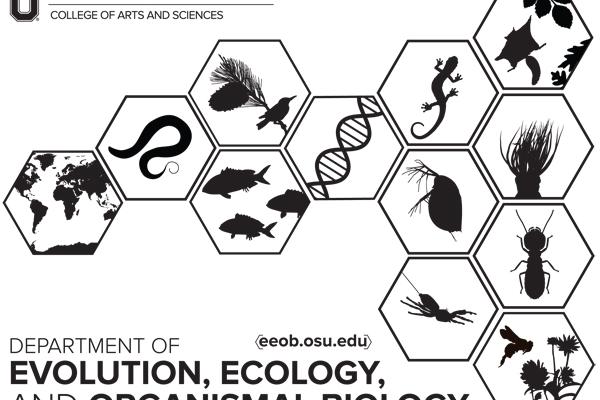Publications by EEOB faculty January 1 - January 31

Level up: the expression of male sexually selected cuticular hydrocarbons is mediated by sexual experience
Susan N. Gershman and Howard D. Rundle. 2016. Animal Behaviour 112:169–177. doi:10.1016/j.anbehav.2015.11.025.
Abstract
We tracked changes in cuticular hydrocarbon (CHC) expression with age in male Drosophila serrata. CHCs associated with increased mating success (CHCβ) changed with male age. Age-specific effects on CHCβ were mediated by social environment. Males with greater access to females expressed higher CHCβ values. Mating, but not visual, olfactory or physical contact with females, altered CHCβ.
Recurrent connections between Amazon and Atlantic forests shaped diversity in Caatinga four-eyed frogs
Thomé, M. T. C., Sequeira, F., Brusquetti, F., Carstens, B., Haddad, C. F. B., Rodrigues, M. T. and Alexandrino, J. 2016. J. Biogeogr. doi:10.1111/jbi.12685
Abstract
The Caatinga is a widespread but poorly known biome in South America. Its historical stability is controversial and different types of evidence provide support to contrasting hypotheses. We investigate how past biome dynamics may have caused diversification in the endemic four-eyed frog genus Pleurodema in the Caatinga biome.
We sampled 353 individuals of Pleurodema alium and Pleurodema diplolister from 60 localities and genotyped them at 12 (P. alium) or 20 (P. diplolister) microsatellite loci. We sequenced a mitochondrial fragment for a subset (199) of the samples. After exploratory analyses to infer genetic structure between and within species, we designed seven biogeographical scenarios based on the literature on species distributions, palaeomodels and geological palaeoindicators. We tested these hypotheses by calculating the posterior probability of models using multilocus approximate Bayesian computation (ABC).
Both markers recovered well-defined interspecific limits with restricted introgression, but population structure within P. diplolister is subtle and affected by isolation by distance. Model selection using ABC supported two scenarios of diversification that included recent demographic growth. Genetic breaks at intra- and interspecific levels were geographically coincident, and correlated with past forest invasions reported in the literature.
Our data support the idea that past expansions of the Amazon and Atlantic forests over the current Caatinga distribution shaped the genetic structure in endemic four-eyed frogs at more than one level by promoting intermittent vicariance. Additional support comes from the distribution patterns of forest and Caatinga taxa. Variation among groups suggests differential organismal responses to past habitat shifts, probably mediated by specific natural-history traits. This paper provides the first direct evidence that taxa endemic to the Caatinga were affected by past forest interactions.
Biogeographic barriers drive co-diversification within associated eukaryotes of the Sarracenia alata pitcher plant system
Satler JD, Zellmer AJ, Carstens BC. 2016. Biogeographic barriers drive co-diversification within associated eukaryotes of the Sarracenia alata pitcher plant system. PeerJ4:e1576 https://doi.org/10.7717/peerj.1576
Abstract
Understanding if the members of an ecological community have co-diversified is a central concern of evolutionary biology, as co-diversification suggests prolonged association and possible coevolution. By sampling associated species from an ecosystem, researchers can better understand how abiotic and biotic factors influence diversification in a region. In particular, studies of co-distributed species that interact ecologically can allow us to disentangle the effect of how historical processes have helped shape community level structure and interactions. Here we investigate the Sarracenia alata pitcher plant system, an ecological community where many species from disparate taxonomic groups live inside the fluid-filled pitcher leaves. Direct sequencing of the eukaryotes present in the pitcher plant fluid enables us to better understand how a host plant can shape and contribute to the genetic structure of its associated inquilines, and to ask whether genetic variation in the taxa are structured in a similar manner to the host plant. We used 454 amplicon-based metagenomics to demonstrate that the pattern of genetic diversity in many, but not all, of the eukaryotic community is similar to that of S. alata, providing evidence that associated eukaryotes share an evolutionary history with the host pitcher plant. Our work provides further evidence that a host plant can influence the evolution of its associated commensals.
